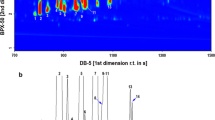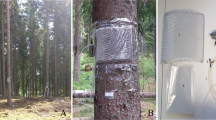Summary.
Antennae of six sympatric bark and ambrosia beetles (Scolytidae), Dendroctonus valens LeConte, Gnathotrichus retusus (LeConte), Hylastes tenuis Eichhoff, Ips mexicanus (Hopkins), Ips plastographus maritimus Lanier, and Pseudohylesinus sericeus (Mannerheim), and two scolytid predators, Enoclerus sphegeus (F.) (Cleridae) and Lascontonus tuberculatus Kraus (Colydiidae), were analyzed by gas chromatographic-electroantennographic detection (GC-EAD) for their responses to synthetic Ips spp. pheromone components, and host and nonhost volatiles. The beetles emerged from cut logs of pitch canker-infected Monterey pine trees, Pinus radiata D. Don. There were significant disparities in EAD response patterns to the hemiterpene and monoterpene alcohol pheromone components that are typically produced by Ips spp. Antennae of I. p. maritimus responded strongly to ( ± )-ipsdienol, ( ± )-ipsenol, amitinol, and lanierone; antennae of I. mexicanus responded strongly to (1S,2S)-(–)-cis-verbenol, with weaker responses to ( ± )-ipsdienol, ( ± )-ipsenol, and amitinol; antennae of H. tenuis responded to (1S, 2R)-(–)-trans-ver-benol, with less pronounced responses to (–)-cis-verbenol and 2-methyl-3-buten-2-ol; and antennae of D. valens, G. retusus, and P. sericeus generally responded to all Ips spp. pheromone components except 2-methyl-3-buten-2-ol (D. valens and G. retusus) and E-myrcenol (G. retusus and P. sericeus). Ips mexicanus responded only to the (–)-enantiomers of ipsenol and ipsdienol, whereas I. p. maritimus responded to (–)-ipsenol, but to both the (+)- and (–)-enantiomers of ipsdienol. The antennae of the two predaceous insects (E. sphegeus and L. tuberculatus) responded to a range of the Ips spp. pheromone components. Host monoterpenes elicited no antennal responses from E. sphegeus, G. retusus, H. tenuis, and I. mexicanus, but several monoterpenes elicited various levels of responses from D. valens and I. p. maritimus antennae. Interestingly, antennae of female D. valens responded to (–), but not (+)-limonene. α- and β-Pinene elicited weak responses from L. tuberculatus antennae. EAD responses to selected nonhost volatiles were almost identical among the six scolytid species, with trans-conophthorin eliciting the strongest response in most cases, followed by three C6- alcohols and two C8-alcohols. The antennal responses by most of these species to linalool or geranylacetone were very weak; (E)-2-hexenal, (Z)-3-hexenyl acetate, and benzyl alcohol elicited almost no response. The response pattern of P. sericeus to nonhost volatiles differed slightly from the rest of the scolytids: a strong response to linalool, weaker response to the C8-alcohols. The two predaceous Coleoptera generally had weak, but detectable, responses to nonhost volatiles, except for a relatively strong response to trans-conophthorin by L. tuberculatus. No notable differences in EAD responses were observed between males and females of the two Ips spp. Our results provide an electrophysiological baseline for future efforts to identify attractive and repellent semiochemicals (aggregation pheromones, host kairomones, or nonhost interruptants) for this guild of scolytids and their key predators that are associated with moribund and pitch canker- infected P. radiata.
Similar content being viewed by others
Author information
Authors and Affiliations
Corresponding author
Rights and permissions
About this article
Cite this article
Zhang, QH., Erbilgin, N. & Seybold, S.J. GC-EAD responses to semiochemicals by eight beetles in the subcortical community associated with Monterey pine trees in coastal California: similarities and disparities across three trophic levels. Chemoecology 18, 243–254 (2008). https://doi.org/10.1007/s00049-008-0411-6
Received:
Accepted:
Published:
Issue Date:
DOI: https://doi.org/10.1007/s00049-008-0411-6




